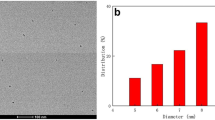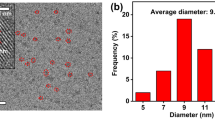Abstract
In this study, an approach for the facile, rapid, energy-saving, and sensitive determination of Fe3+ and Cr(VI) was developed. L-arginine/D-glucose carbon quantum dots (Arg/Glu-CQDs), with a photoluminescence quantum yield of 21%, were synthesized from L-arginine and D-glucose through a facile, hydrothermal process. The maximum emission wavelength of Arg/Glu-CQDs was observed at 450 nm, under an excitation wavelength of 365 nm. In addition, Arg/Glu-CQDs exhibited a sensitive and selective response to Fe3+ compared to Fe2+ and other metal ions. The Arg/Glu-CQDs’ fluorescence was noticeably quenched through the inner filter effect (IFE) when Arg/Glu-CQDs were mixed with Fe3+. Accordingly, the Arg/Glu-CQDs/Fe2+ system could selectively detect Cr(VI); Cr(VI) could oxidize Fe2+ to Fe3+ and quench the fluorescence. The fluorescence sensor system (i.e., the Arg/Glu-CQDs/Fe2+ system) showed high sensitivity and excellent selectivity for the detection of Fe3+ and Cr(VI) in river water samples. Satisfactory detection efficiencies ranging from 97.07 to 103.46% were obtained. The cytotoxicity of Arg/Glu-CQDs was evaluated through an MTT assay using A549 cells as the target, to extend the application of Arg/Glu-CQDs to biological systems; the MTT assay indicated that the Arg/Glu-CQDs is non-cytotoxicity. Arg/Glu-CQDs were also successfully imaged in A549 cells indicating further application possibilities in bioimaging.

Graphical abstract








Similar content being viewed by others
Data availability
The datasets used and analyzed during the current study are available from the corresponding author on reasonable request.
References
Atchudan R, Edison TNJI, Aseer KR, Perumal S, Karthik N, Lee YR (2018) Highly fluorescent nitrogen-doped carbon dots derived from Phyllanthus acidus utilized as a fluorescent probe for label-free selective detection of Fe3+ ions, live cell imaging and fluorescent ink. Biosens Bioelectron 99:303–311
Banerjee M, Bar N, Basu RK, Das SK (2017) Comparative study of adsorptive removal of Cr (VI) ion from aqueous solution in fixed bed column by peanut shell and almond shell using empirical models and ANN. Environ Sci Pollut R 24:10604–10620
Calabro RL, Yang DS, Kim DY (2018) Liquid-phase laser ablation synthesis of graphene quantum dots from carbon nano-onions: comparison with chemical oxidation. J Colloid Interface Sci 527:132–140
Chatzimitakos T, Kasouni Sygellou AL, Avgeropoulos A, Troganis A, Stalikas C (2017) Two of a kind but different: luminescent carbon quantum dots from Citrus peels for iron and tartrazine sensing and cell imaging. Talanta 175:305–312
Chauhan N, Anand SR, Aggarwal R, Kaushik J, Shekhawat SS, Sonker AK, Sonkar SK (2019) Soluble non-toxic carbon nano-rods for the selective sensing of iron (iii) and chromium (vi). New J Chem 43:10726–10734
Chen K, Qing W, Hu W, Lu M, Wang Y, Liu X (2019) On-off-on fluorescent carbon dots from waste tea: their properties, antioxidant and selective detection of CrO42−, Fe3+, ascorbic acid and L-cysteine in real samples. Spectrochim Acta A 213:228–234
Chen L, Wu C, Du P, Feng X, Wu P, Cai C (2017) Electrolyzing synthesis of boron-doped graphene quantum dots for fluorescence determination of Fe3+ ions in water samples. Talanta 164:100–109
Cui X, Liu M, Li B (2012) Homogeneous fluorescence-based immunoassay via inner filter effect of gold nanoparticles on fluorescence of CdTe quantum dots. Analyst. 137:3293–3299
Darwin K, Wei HC (2020) Microplasma-enabled colloidal nitrogen-doped graphene quantum dots for broad-range fluorescent pH sensors. Carbon. 167:675–684
Fang B, Wang P, Zhu YJ, Wang GY, Zhang G, Zheng XS, Ding C, Gu JJ, Cao FF (2018) Basophilic green fluorescent carbon nanoparticles derived from benzoxazine for the detection of Cr (vi) in a strongly alkaline environment. RSC Adv 8:7377–7382
Gao X, Lu Y, He S, Li X, Chen W (2015) Colorimetric detection of iron ions (III) based on the highly sensitive plasmonic response of the N-acetyl-l-cysteine-stabilized silver nanoparticles. Anal Chim Acta 879:118–125
Guan JS, Huang J, He D, He X, Wang K, Ye R, Yang X, Qing T, Tang J (2017) Highly Fe3+ selective fluorescent nanoprobe based on ultrabright N/P codoped carbon dots and its application in biological samples. Anal Chem 89:7477–7484
Guo L, Li L, Liu M, Wan Q, Tian J, Huang Q, Wen Y, Liang S, Zhang X, Wei Y (2018) Bottom-up preparation of nitrogen doped carbon quantum dots with green emission under microwave-assisted hydrothermal treatment and their biological imaging. Mater Sci Eng C 84:60–66
Han J, Bu X, Zhou D, Zhang H, Yang B (2014) Discriminating Cr (III) and Cr (VI) using aqueous CdTe quantum dots with various surface ligands. RSC Adv 4:32946–32952
Hopkins L, Forbes T, Schneider B, Constant SL, Leitenberg D, Schwartz AM, Patierno SR, Ceryak S (2012) Role of the inflammasome complex in Cr (VI)-induced lung injury and inflammation. Cancer Res 78:5734–5747
Hua J, Yang J, Zhu Y, Zhao C, Yang Y (2017) Highly fluorescent carbon quantum dots as nanoprobes for sensitive and selective determination of mercury (II) in surface waters. Spectrochim Acta A 187:149–155
Kajisa T, Sakata T (2017) Glucose-responsive hydrogel electrode for biocompatible glucose transistor. Sci Technol Adv Mater 18:26–33
Kartikasari AE, Visseren FL, Marx JJ, Mullekom SVJH, Kats-Renaud VBS, Asbeck V, Ulfman LH, Georgiou NA (2009) Intracellular labile iron promotes firm adhesion of human monocytes to endothelium under flow and transendothelial migration: iron and monocyte–endothelial cell interactions. Atherosclerosis 205:369–375
Lee JW, Oh SH, Kim JH, Byun EH, Kim MR, Baek M, Byun MW (2007) The effect of irradiation temperature on the non-enzymatic browning reaction in cooked rice. Radiat Phys Chem 76:886–892
Li DY, Wang SP, Azad F, Su SC (2020) Single-step synthesis of polychromatic carbon quantum dots for macroscopic detection of Hg2+. Ecotox Environ Safe 190:6513–6519
Li R, Wang X, Li Z, Zhu H, Liu J (2018) Folic acid-functionalized graphene quantum dots with tunable fluorescence emission for cancer cell imaging and optical detection of Hg2+. New J Chem 42:4352–4360
Li W, Simmons P, Shrader D, Herrman TJ, Dai SY (2013) Microwave plasma-atomic emission spectroscopy as a tool for the determination of copper, iron, manganese and zinc in animal feed and fertilizer. Talanta. 112:43–48
Lu M, Zhou L (2019) One-step sonochemical synthesis of versatile nitrogen-doped carbon quantum dots for sensitive detection of Fe2+ ions and temperature in vitro. Mater Sci Eng C 101:352–359
Luo XM, Bai PX, Wang XC, Zhao GH, Feng JY, Ren HJ (2019) Preparation of nitrogen-doped carbon quantum dots and its application as a fluorescent probe for Cr (VI) ion detection. New J Chem 43:5488–5494
Ma Y, Cen Y, Sohail M, Xu GH, Wei FD, Shi ML, Xu XM, Song YY, Ma YJ, Hu Q (2017) A ratiometric fluorescence universal platform based on N, Cu codoped carbon dots to detect metabolites participating in H2O2-generation reactions. ACS Appl Mater Interfaces 9(38):33011–33019
Milto IV, Suhodolo I, Prokopieva V, Klimenteva T (2016) Molecular and cellular bases of iron metabolism in humans. Biochem Mosc 81:549–564
Ming F, Hou J, Hou C, Yang M, Wang X, Li J, Huo D, He Q (2019) One-step synthesized fluorescent nitrogen doped carbon dots from thymidine for Cr (VI) detection in water. Spectrochim Acta A 222:117165
Mondal TK, Mondal S, Ghorai UK, Saha SK (2019) White light emitting lanthanide based carbon quantum dots as toxic Cr (VI) and pH sensor. J Colloid Interface Sci 553:177–185
Morris VB, Sharma CP (2010) Enhanced in-vitro transfection and biocompatibility of L-arginine modified oligo (-alkylaminosiloxanes)-graft-polyethylenimine. Biomaterials. 31:8759–8769
Mu Z, Hua J, Feng S, Yang YL (2019) A ratiometric fluorescence and light scattering sensing platform based on Cu-doped carbon dots for tryptophan and Fe (III). Spectrochim Acta A 219:248–256
Ni P, Li Q, Xu C, Lai H, Bai Y, Chen T (2019) Optical properties of nitrogen and sulfur co-doped carbon dots and their applicability as fluorescent probes for living cell imaging. Appl Surf Sci 494:377–383
Pan D, Zhang J, Li Z, Wu M (2010) Hydrothermal route for cutting graphene sheets into blue-luminescent graphene quantum dots. Adv Mater 22:734–738
Roshni V, Misra S, Santra MK, Ottoor D (2019) One pot green synthesis of C-dots from groundnuts and its application as Cr (VI) sensor and in vitro bioimaging agent. J Photoch Photobio A 373:28–36
Sachdev A, Gopinath P (2015) Green synthesis of multifunctional carbon dots from coriander leaves and their potential application as antioxidants, sensors and bioimaging agents. Analyst. 140(12):4260–4269
Stauffer MT, Hunter LJ, Troncone SK (2007) Determination of iron in abandoned mine drainage by UV-vis spectrophotometry and flame atomic absorption spectrophotometry. Spectrosc Lett 40:429–437
Wang Q, Zheng H, Long Y, Zhang L, Gao M, Bai W (2011) Microwave–hydrothermal synthesis of fluorescent carbon dots from graphite oxide. Carbon 49:3134–3140
Wu H, Jiang J, Gu X, Tong C (2017) Nitrogen and sulfur co-doped carbon quantum dots for highly selective and sensitive fluorescent detection of Fe (III) ions and L-cysteine. Microchim Acta 184:2291–2298
Xiao SJ, Chu ZJ, Zuo J, Zhao XJ, Huang CZ, Zhang L (2017) Fluorescent carbon dots: facile synthesis at room temperature and its application for Fe2+ sensing. J Nanopart Re 19:84
Xu TT, Yang JX, Song JM, Chen JS, Niu HL, Mao CJ, Zhang SY, Shen YH (2017) Synthesis of high fluorescence graphene quantum dots and their selective detection for Fe3+ in aqueous solution. Sensor Actuat B-Chem 243:863–872
Yan Z, Qu X, Niu Q, Tian C, Fan C, Ye B (2016) A green synthesis of highly fluorescent nitrogen-doped graphene quantum dots for the highly sensitive and selective detection of mercury (II) ions and biothiols. Anal Methods 8:1565–1571
Yang R, Guo X, Jia L, Zhang Y, Zhao Z, Lonshakov F (2017) Green preparation of carbon dots with mangosteen pulp for the selective detection of Fe3+ ions and cell imaging. Appl Surf Sci 423:426–432
Zhang C, Cui Y, Song L, Liu X, Hu Z (2016) Microwave assisted one-pot synthesis of graphene quantum dots as highly sensitive fluorescent probes for detection of iron ions and pH value. Talanta 150:54–60
Zhang M, Cao X, Li H, Guan F, Guo J, Shen F, Luo Y, Sun C, Zhang L (2012) Sensitive fluorescent detection of melamine in raw milk based on the inner filter effect of Au nanoparticles on the fluorescence of CdTe quantum dots. Food Chem 135:1894–1900
Zhang Y, Guo S, Huang H, Mao G, Ji X, He Z (2018) Silicon nanodot-based aptasensor for fluorescence turn-on detection of mucin 1 and targeted cancer cell imaging. Anal Chim Acta 1035:154–160
Zheng M, Ruan S, Liu S, Sun T, Qu D, Zhao H, Xie Z, Gao H, Jing X, Sun Z (2015) Self-targeting fluorescent carbon dots for diagnosis of brain cancer cells. ACS Nano 9:11455–11461
Funding
This work was financially supported by the Key Technologies Research and Development Program (2016YFC0501205, 2016YFC0501208 and 2017YFD0200706), and the National Natural Science Foundation of China (21775163).
Author information
Authors and Affiliations
Contributions
Conceptualization: Zijun Xu; Formal analysis and investigation: Jin Liu, Kejia Wang; Writing - original draft preparation: Zijun Xu, Binwei Yan; Writing-review and editing: Xueqin Ren, Zideng Gao; Funding acquisition: Xueqin Ren, Shuwen Hu; Supervision: Xueqin Ren, Zideng Gao.
Corresponding authors
Ethics declarations
Competing interests
The authors declare that they have no conflicts of interest.
Ethical approval
Approval was obtained from the ethics committee of China Agricultural University. The procedures used in this study adhere to the tenets of the Declaration of Helsinki.
Consent to participate
Informed consent was obtained from all individual participants included in the study.
Consent to publish
The participant has consented to the submission of the case report to the journal.
Additional information
Responsible Editor: Santiago V. Luis
Publisher’s note
Springer Nature remains neutral with regard to jurisdictional claims in published maps and institutional affiliations.
Supplementary Information
ESM 1
(DOC 1671 kb)
Rights and permissions
About this article
Cite this article
Xu, Z., Liu, J., Wang, K. et al. Facile synthesis of N-doped carbon dots for direct/indirect detection of heavy metal ions and cell imaging. Environ Sci Pollut Res 28, 19878–19889 (2021). https://doi.org/10.1007/s11356-020-11880-z
Received:
Accepted:
Published:
Issue Date:
DOI: https://doi.org/10.1007/s11356-020-11880-z




